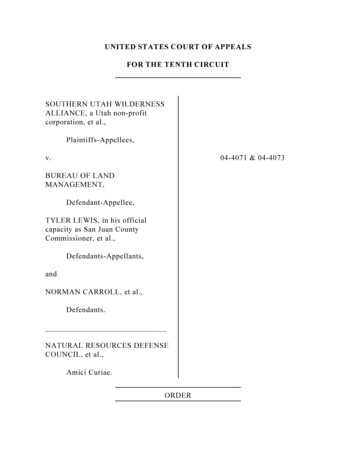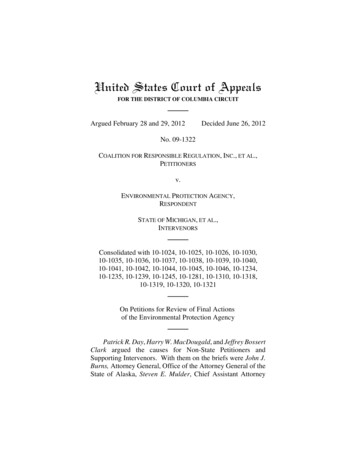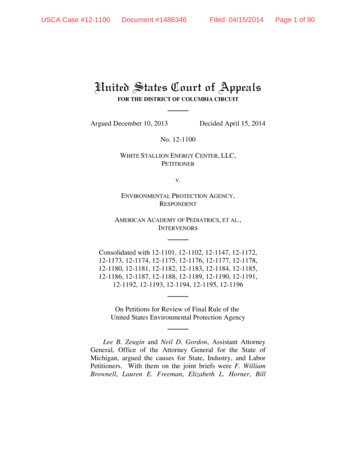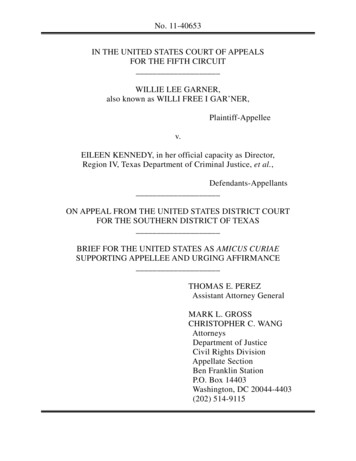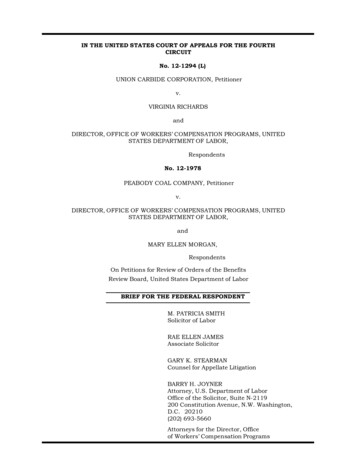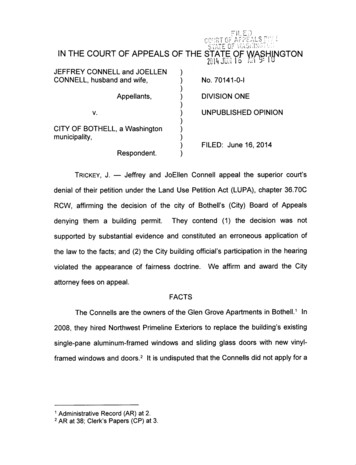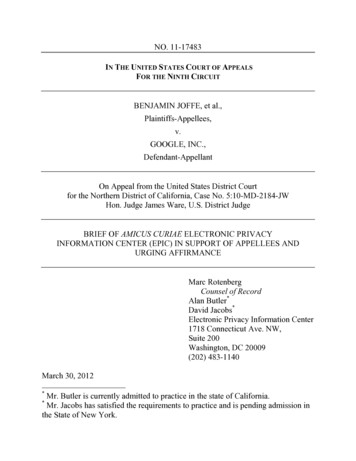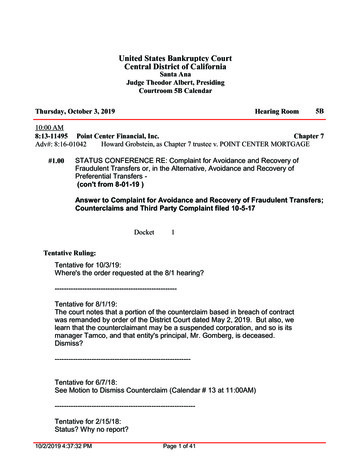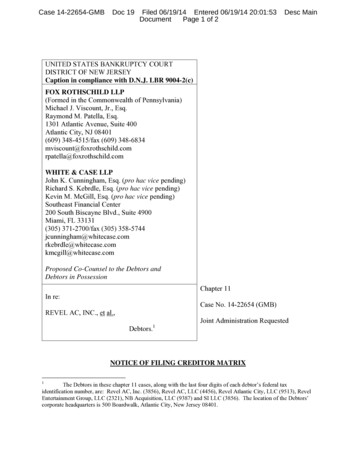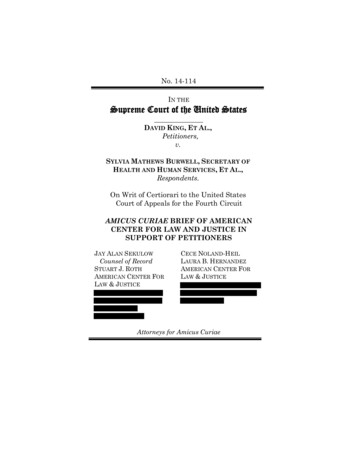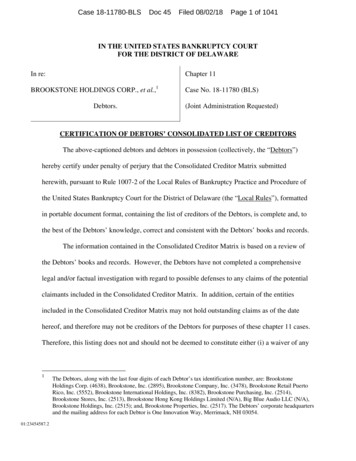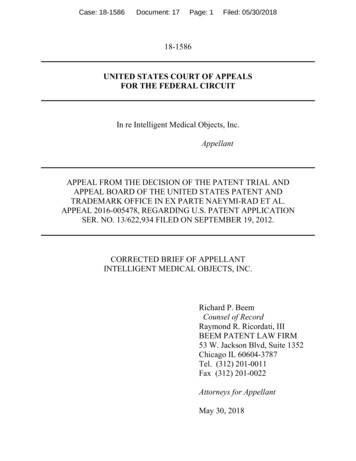
Transcription
Case: 18-1586Document: 17Page: 1Filed: 05/30/201818-1586UNITED STATES COURT OF APPEALSFOR THE FEDERAL CIRCUITIn re Intelligent Medical Objects, Inc.AppellantAPPEAL FROM THE DECISION OF THE PATENT TRIAL ANDAPPEAL BOARD OF THE UNITED STATES PATENT ANDTRADEMARK OFFICE IN EX PARTE NAEYMI-RAD ET AL.APPEAL 2016-005478, REGARDING U.S. PATENT APPLICATIONSER. NO. 13/622,934 FILED ON SEPTEMBER 19, 2012.CORRECTED BRIEF OF APPELLANTINTELLIGENT MEDICAL OBJECTS, INC.Richard P. BeemCounsel of RecordRaymond R. Ricordati, IIIBEEM PATENT LAW FIRM53 W. Jackson Blvd, Suite 1352Chicago IL 60604-3787Tel. (312) 201-0011Fax (312) 201-0022Attorneys for AppellantMay 30, 2018
Case: 18-1586Document: 17Page: 2Filed: 05/30/2018CERTIFICATE OF INTERESTCounsel for the Appellant, Intelligent Medical Objects, Inc. (IMO), certifiesthe following:1.The full name of the party being represented by me is: IntelligentMedical Objects, Inc.2.The name of the real party in interest represented by me is: IntelligentMedical Objects, Inc.3.All parent corporations and any publicly held companies that own 10percent or more of the stock of the party represented by me is:4.A.IMO Parent, Inc.B.IMO Investor Holdings, Inc.The names of all law firms and the partners or associates whoappeared for Intelligent Medical Objects, Inc. in proceedings before the UnitedStates Patent Office, or are expected to appear in this Court, are:Beem Patent Law FirmRichard P. BeemRaymond R. Ricordati, IIIJohn R Linzer5.The title and number of any case known to counsel to be pending inthis or any other court or agency that will directly affect or be directly affected bythis court’s decision in the pending appeal:Nonei
Case: 18-1586Document: 17Date: May 30, 2018Page: 3Filed: 05/30/2018By: /s/ Richard P. BeemRichard P. Beemii
Case: 18-1586Document: 17Page: 4Filed: 05/30/2018TABLE OF CONTENTSCERTIFICATE OF INTEREST . iTABLE OF AUTHORITIES . viSTATEMENT OF RELATED CASES . viiiJURISDICTIONAL STATEMENT . 1STATEMENT OF THE ISSUE PRESENTED . 1STATEMENT OF THE CASE . 1STATEMENT OF FACTS . 2A.IMO harnesses computer technology to manageelectronic medical records (EMR). 2B.Prior EMR systems had technical problems . 3C.IMO developed and claimed technical solutions. 41.Claim 1 recites a specific method for tagging data in atechnically efficient LEMR with a controlled medical vocabulary. 52.For example, asthma is treated, and data iscollected, in multiple visits . 73.Claim 12 recites a specific method for tagging sound wavedictation files with a source vocabulary . 11SUMMARY OF THE ARGUMENT . 12STANDARD OF REVIEW . 12ARGUMENT . 13A.Claims 1 and 12 are directed to eligiblesubject matter (Alice step one). 15iii
Case: 18-1586Document: 17Page: 5Filed: 05/30/20181.The Board oversimplifies the claims . 162.The claims recite concrete details . 173.a.Claims 1 and 12 improve computer functionality. 18b.Claim 12 also transforms real-world data . 20c.Claims 1 and 12 do not preempt healthcare . 21These specific limitations repeatedly have been deemedeligible by the Patent Office . 22a. The Patent Office agreed post-Mayo that the LEMRlimitations are eligible in the parent application. 22b. The Patent Office also agreed post-Alicethat the LEMR limitations are eligible . 25c. The other three patents in the family have all issuedwith similar claimed technologies . 26B.Claims 1 and 12 recite additional elements that amountto significantly more than the alleged judicialexception (Alice step two) . 271.The claims recite technical features, nothigh-level generalities . 272.The Board improperly shifted to IMO theburden to address “conventionality” . 303.The Board repeated its faulty step one reasoninginstead of applying the proper test under step two . 334.The Board disregarded as optional the Patent Office’sown guidance and this Court’s case law . 34CONCLUSION . 36ADDENDUMiv
Case: 18-1586Document: 17CERTIFICATE OF SERVICECERTIFICATE OF COMPLIANCEvPage: 6Filed: 05/30/2018
Case: 18-1586Document: 17Page: 7Filed: 05/30/2018TABLE OF AUTHORITIESCasesAlice Corp. Pty. Ltd. v. CLS Bank Int’l,134 S.Ct. 2347 (2014) . passimBascom Global Internet Servs., Inc. v. AT&T Mobility LLC,827 F.3d 1341 (Fed. Cir. 2016) . 14, 29, 32Berkheimer v. HP Inc.,881 F.3d 1360 (Fed. Cir. 2018) . 12, 15, 30, 32buySAFE, Inc. v. Google, Inc., 765 F.3d 1350 (Fed. Cir. 2014) . 17Content Extraction and Transmission, LLC v. Wells FargoBank, N.A., 776 F.3d 1343 (Fed. Cir. 2014) . 27Core Wireless Licensing S.A.R.L. v. LG Elecs. Inc.,880 F.3d 1356 (Fed. Cir. 2018) . 13, 20DDR Holdings, LLC v. Hotels.com,773 F.3d 1245 (Fed. Cir. 2014) . 14, 29, 34, 35Digitech Image Techs., LLC v. Elec. for Imaging, Inc.,758 F.3d 1344 (Fed. Cir. 2014) . 28Enfish LLC v. Microsoft Corp.,822 F.3d 1327 (Fed. Cir. 2016) . 13, 15-18, 34Intellectual Ventures I LLC v. Capital One Bank (USA),792 F.3d 1363 (Fed. Cir. 2015) . 17Intellectual Ventures I LLC v. Erie Indemnity Co.,850 F.3d 1315 (Fed. Cir. 2017) . 31, 34Mayo Collaborative Servs. v. Prometheus Labs., Inc.,566 U.S. 66 (2012) .13-14, 22, 26, 28, 33vi
Case: 18-1586Document: 17Page: 8Filed: 05/30/2018McRO, Inc. v. Bandai Namco Games Am., Inc.,837 F.3d 1299 (Fed. Cir. 2016) . 16, 17, 19, 20, 27Salwan, In re, No. 16-2079, slip op.(Fed. Cir. March 13, 2017) (nonprec.). 17SAP Amer., Inc. v. InvestPic, LLC, No. 17-2081, slip op.(Fed. Cir. May 15, 2018) . 17Smith, In re, 815 F.3d 816 (Fed. Cir. 2016) . 12Thales Visionix Inc. v. U.S., 850 F.3d 1343 (Fed. Cir. 2017) . 20Visual Memory LLC v. NVIDIA Corp.,867 F.3d 1253 (Fed. Cir. 2017) . 17Voter Verified, Inc. v. Election Systems & Software LLC,887 F.3d 1376 (Fed. Cir. 2018) . 22, 26Statutes35 U.S.C. 101.1, 12-13, 16, 22, 25, 26, 30vii
Case: 18-1586Document: 17Page: 9Filed: 05/30/2018STATEMENT OF RELATED CASESPursuant to Federal Circuit Rule 47.5, appellant states as follows:(a) There have been no previous appeals in this case.(b) Counsel is unaware of any pending case that will directly affect or bedirectly affected by the Court’s decision in this case.viii
Case: 18-1586Document: 17Page: 10Filed: 05/30/2018JURISDICTIONAL STATEMENTThis Court has jurisdiction over Intelligent Medical Object’s (IMO’s) appealof the Patent Trial and Appeal Board’s (Board’s) December 22, 2017 final decision(Appx0001-0016) pursuant to 28 U.S.C. §1295(a)(4)(A). IMO filed a timely noticeof appeal on February 15, 2018.STATEMENT OF THE ISSUE PRESENTEDWhether the Board erred as a matter of law in distilling novel, non-obvious,electronic medical record (EMR) method claims into a Section 101 ineligiblesystem of “collecting, storing and organizing data” and shifting the burden to IMOto establish non-conventionality of the claimed invention.STATEMENT OF THE CASEU.S. Patent Application 13/622,934 (the ’934 application), the only memberof its family not yet issued as a patent, was filed on September 19, 2012.Appx0099. Following a series of Office Actions and responses, the pending claimswere deemed to be novel and non-obvious over the prior art, but were finallyrejected as allegedly being directed to non-eligible subject matter under Section101. Appx0479 (Office Action dated March 13, 2015) (“Claims 1-14 . . . appearallowable if rewritten to overcome the 35 U.S.C. 101 issues”). IMO appealed, andthe Board upheld the rejection. Appx0001-0016.1
Case: 18-1586Document: 17Page: 11Filed: 05/30/2018STATEMENT OF FACTSA.IMO harnesses computer technology to manageelectronic medical records (EMR)Intelligent Medical Objects, Inc. (IMO) is the world’s leading provider ofmedical vocabulary software applications that allow doctors to capture andpreserve truth (or clinical intent) at the point of care. See Appx0253-0254 (Spec. at¶¶10-25) (“capturing the complete depth of information contained within data”).The IMO “controlled” medical vocabulary includes over 6 million termsthat, in turn, map to numerous code sets, including the claimed “administrativeterminology” (e.g., 68,000 ICD-10-CM billing codes) and “reference terminology”(e.g., 300,000 SNOMED clinical decision support codes), where those code setsare used as inputs by multiple software applications. Appx0254; Appx0267-0268(Spec. at ¶¶ 15, 122-29).1 Those external mappings have been proved to have 99%accuracy in a peer-reviewed study published by the U.S. Centers for DiseaseControl and Prevention (CDC). Appx0630.The increased granularity that results from IMO’s controlled vocabulary andits mappings to those terminologies permits the capture of greater meaning while1Citations to the specification of the ’934 application refer to paragraph numbersin the clean version of the substitute specification filed on November 28, 2012(Appx0251-0291) and drawings as originally submitted (Appx0153-0198). Thefile history can be found at Appx0021-0651. Citations in the Board’s decision referto paragraph numbers in the published application.2
Case: 18-1586Document: 17Page: 12Filed: 05/30/2018increasing complexity of the underlying data architecture. Appx0252; Appx0254;Appx0267-0268; Appx0273 (Spec. at ¶¶ 10, 15, 122-29, 177). Medical data isexponentially more complicated than other types of data because it involves manyto-many relationships. Appx0261 (Spec at ¶ 63). For example, there are manypatients, doctors, diagnoses, procedures, and prescriptions. Appx0255-0257 (Spec.at ¶17-21). Many-to-many relationships defy traditional relational databases.Appx0263 (Spec. at ¶ 77). They are best accommodated with graph structures, butgraphs bog down quickly as additional data is added, for example, as medicaltreatment progresses over time and as more patients and more doctors are addedinto the system. Appx0270-0272 (Spec. at ¶¶156, 170-74); Appx0881 (U.S. Patent7,693,917 at 1:36-2:3); Appx0883-0884 (U.S. Patent 7,693,917 at 5:51-7:3).B.Prior EMR systems had technical problemsThe background of U.S. Patent Application 13/622,934 (the ’934application) explains that a typical workflow for patient care may be defined by aseries of visits in which the patient is analyzed subjectively (patient history) andobjectively (physical exam), the patient’s condition is assessed, and a treatmentplan is created (referred to as SOAP). Appx0262 (Spec. at ¶ 76).Existing systems relied on standard relational database models and wereeither incapable of dealing with follow-up visits or failed to recognize themaltogether. Appx0263 (Spec. at ¶ 77). On the other hand, directed graphs are3
Case: 18-1586Document: 17Page: 13Filed: 05/30/2018inherently difficult to use, as explained at length in IMO’s ’934 application andU.S. Patent 7,693,917 (the ’917 patent), incorporated by reference. Appx02700272 (Spec. at ¶¶156, 170-74); Appx0864-0911; Appx0881 (’917 patent at 1:362:3); Appx0883-0884 (’917 patent at 5:51-7:3). Relationships among the patient’sconditions, assessments and treatments over time were lost and inaccuracies wereintroduced, requiring expensive, time-consuming, haphazard data cleansing to fix.Appx0263; Appx0273 (Spec. at ¶ 77, 177).C.IMO developed and claimed technical solutionsTo address these problems, IMO developed unique methods ofimplementing longitudinal electronic medical records (LEMR) that store patientinformation properly over time. Appx0251-0252 (Spec. at ¶¶ 3-7). The ’934application, entitled “Method for Implementing a Controlled Medical Vocabulary,”describes and claims a longitudinal electronic medical record (LEMR) thatproperly tracks relationships among data elements generated at multiple points intime (Appx0252-0253 (Spec. at ¶¶ 10-12)) and in which a controlled medicalvocabulary is implemented to ensure data normalization (accuracy) whilemaintaining clinical intent (Appx0273 (Spec. at ¶ 177)).The ’934 application includes two independent claims, claim 1 and claim12.2 The Patent Office has deemed both claims novel and non-obvious; eligibility2A complete list of pending claims is included in the Appendix at Appx0528-0530.4
Case: 18-1586Document: 17Page: 14Filed: 05/30/2018is the sole issue on appeal. Appx0479 (Office Action dated March 13, 2015).1.Claim 1 recites a specific method for tagging data in atechnically efficient LEMR with a controlled medical vocabularyClaim 1 recites and is explained in plain English as follows:Claim 1 of the ’934 application1.A method of implementing a controlledvocabulary in a longitudinal electronic medicalrecord, comprising:generating a first instance of a plurality of dataobjects during a first encounter, said plurality ofdata objects comprising data elements furthercomprising a first instance identifier and temporalidentifiers;linking a data object in said first instance to asummarization reference with a pointer, where theplurality of data objects and the summarizationreference are related as part of a directed graph datastructure;creating an additional instance of a plurality of dataobjects during a later encounter, said additionalinstance of a plurality of data objects comprisingdata elements further comprising an additionalinstance identifier and temporal identifier;providing continuity for said plurality of dataobjects of said first instance over time;capturing said controlled vocabulary using acomputer by forming a list of medical terms andlist of associated descriptions;creating a list of codes internal to said controlledvocabulary;storing said codes, said medical terms, and saiddescriptions using a computer in a format suitablefor use in the longitudinal electronic medicalrecord; and5Plain EnglishLEMR with vocabularytagging by:generating data from apatient’s first visit with adoctorcreating a directed graphby linking visit-level datawith summary referenceswith pointersgenerating data from thepatient’s second visit witha doctor,linking relevant data fromfirst visit and second visits,and updating summariesIMO’s 6 million termscodes for each of IMO’s 6million termsstoring the codes forIMO’s 6 million terms inproper format
Case: 18-1586Document: 17Page: 15Claim 1 of the ’934 applicationtagging elements within a domain within thelongitudinal medical record with said controlledvocabulary;wherein said controlled vocabulary maps to at leastone of a reference terminology or an administrativeterminology; andwherein said providing step comprises tracking arelationship between said data object of said firstinstance and a data object of said additional instance.Filed: 05/30/2018Plain Englishtagging data from eachvisit with codes for IMO’sterms (preserving semanticmeaning by not changingunderlying data)mapping codes to otherterminologies, such as ICDor SNOMEDlinking data from first andsecond visits for trackingdata and revisionsThus, the method recited in claim 1 generates instance data at multiple visitsand links the data across visits, maintaining data continuity and revision history,reducing the need for data cleansing and the need to store duplicative data objects.Appx0252-0253; Appx0256-0257; Appx0263; Appx0274-0278; Appx0160-0162(Spec. at ¶¶ 11-12, 20, 28, 77, 202-243 and Figures 8-10). This method alsoincreases flexibility because it allows data objects to be “polymorphic,” meaningthose data objects can be processed differently or assigned to different data types indifferent contexts. Appx0256 (Spec. at ¶ 20).By linking visit-level data objects to summarization references usingpointers, the system increases speed and efficiency of processing records byquickly displaying the current state of the patient and alleviating the need to storeduplicative data objects in separate summary objects. Appx0263; Appx0274-0278;Appx0160-0162 (Spec. at ¶¶ 78, 212, 202-243 and Figures 8-10).By tagging data objects with a controlled medical vocabulary rather than6
Case: 18-1586Document: 17Page: 16Filed: 05/30/2018changing underlying data, data normalization and interoperability are increased,reducing or eliminating the need for data cleansing, which improves efficiency andaccuracy in processing records and connecting to other providers’ systems.Appx0252; Appx0254; Appx0267-0268; Appx0273 (Spec. at ¶¶ 10, 15, 122-29,177).2.For example, asthma is treated, and data is collected, inmultiple visitsThe example described in paragraphs 202-243 of the specification andillustrated in Figures 8-10 highlights technical aspects and benefits of the claimedsolutions. Appx0274-0278; Appx0160-0162. Patient and relationship data arecollected and updated over the course of three patient visits relating to an asthmaproblem. Appx0274 (Spec. at ¶ 204). The data collection and linking processesrecited in the claim will now be explained in the context of the first two visits, asshown in Figures 8 and 9, reproduced below.During the first visit, a new medical record and an instance (visit) record arecreated (as recited in claim 1). Appx0160; Appx0275 (Spec. at Figure 8 and ¶ 206).The visit data also is linked to a summarization reference data objects usingpointers, rather than storing the data again in a separate summarization reference.Appx0275 (Spec. at ¶ 212). The patient and relationship data are shown in Figure8, reproduced here:7
Case: 18-1586Document: 17Page: 17Filed: 05/30/2018Appx0160. Thus, Figure 8 shows data collected during a first visit and thegeneration of summarization reference data objects and pointers to the underlyingvisit data.During the second visit, new instanc
Intelligent Medical Objects, Inc. (IMO) is the world’s leading provider of medical vocabulary software applications that allow doctors to capture and preserve truth (or clinical
